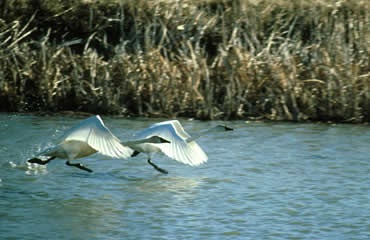If you live near an east or west coastline in the United States, the Mississippi River or any of the five Great Lakes, Utah’s Great Salt Lake or nearby marshland adjacent to these large bodies of water, you’ll know spring is near when great flocks of waterfowl begin their return to the Arctic tundra.
Among them is the Tundra Swan, Cygnus columbianus, a large, elegant bird which has also been called a whistling swan, although they sound more like geese. Tundra Swans are often confused with Mute Swans or Trumpeter Swans which do not have the Tundra Swan’s small yellow patch between the base of the eye and base of the bill.
Like many migratory birds, they’re noisy travelers. It’s hard to miss the sound of spring migration when some flocks number in the thousands.
You can listen to them here.
Tundra swans are about four feet in length, and weigh about 15 pounds. Their long, extended necks, graceful in rest with a slight s-curve, are about equal to the length of their bodies.
Last fall, the swans migrated in late October and early November from their nesting areas in the sub-Arctic and Arctic tundra regions on northern coast of Alaska, the Northwest Territories and Baffin Island, Canada.
 While some swans traveled toward western states and the Pacific Northwest, others settled in wetlands of Utah, and a larger group traversed the flyway from Quebec, Lakes Huron, Michigan and Erie to take their winter rest along the Chesapeake Bay area, and into the North Carolina and farther south.
While some swans traveled toward western states and the Pacific Northwest, others settled in wetlands of Utah, and a larger group traversed the flyway from Quebec, Lakes Huron, Michigan and Erie to take their winter rest along the Chesapeake Bay area, and into the North Carolina and farther south.
One place to observe the migration is in Utah, where the Division of Wildlife Resources sponsors an annual Tundra Swan Day, this year on March 14, at the Salt Creek Waterfowl Management Area, west of Corinne. Admission is free.
Binoculars or spotting scopes will be helpful, according to Phil Douglass, regional conservation outreach manager.
Viewing the migration is a thrilling event, no matter where you live.
"Just seeing and hearing the variety of waterfowl at Salt Creek is worth the trip," Douglass said, "but knowledgeable and friendly people from the DWR and Wasatch Audubon will also be available to answer any questions you have.”
For more information about Utah’s swan viewing day, click here.
A free fact sheet on Tundra Swans is also available here.
– Photos courtesy USFWS